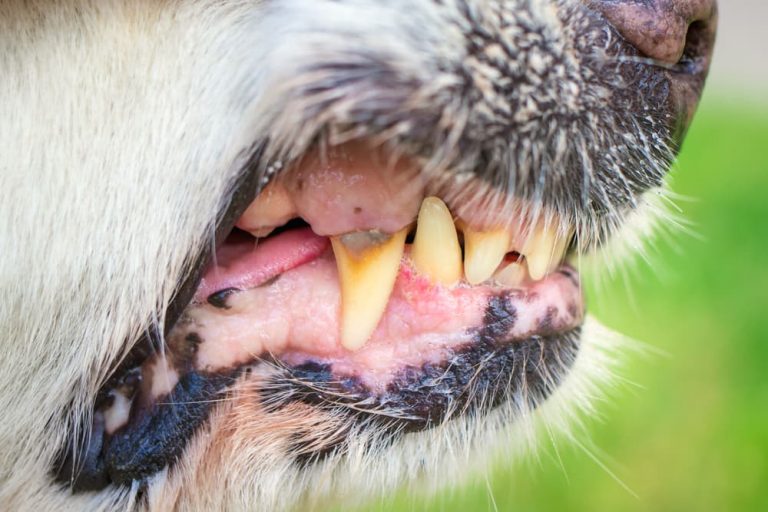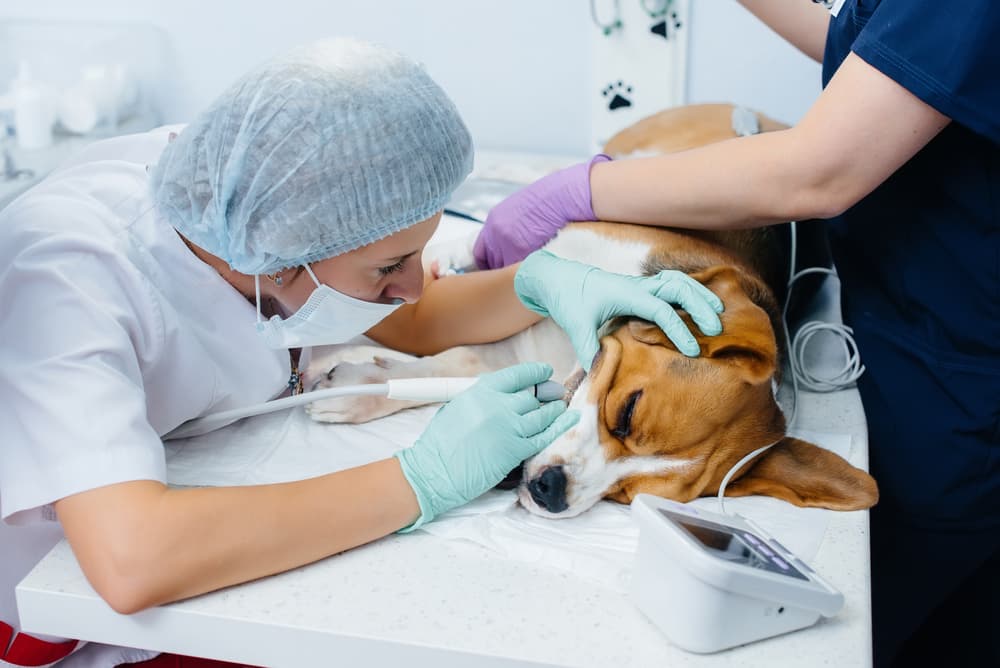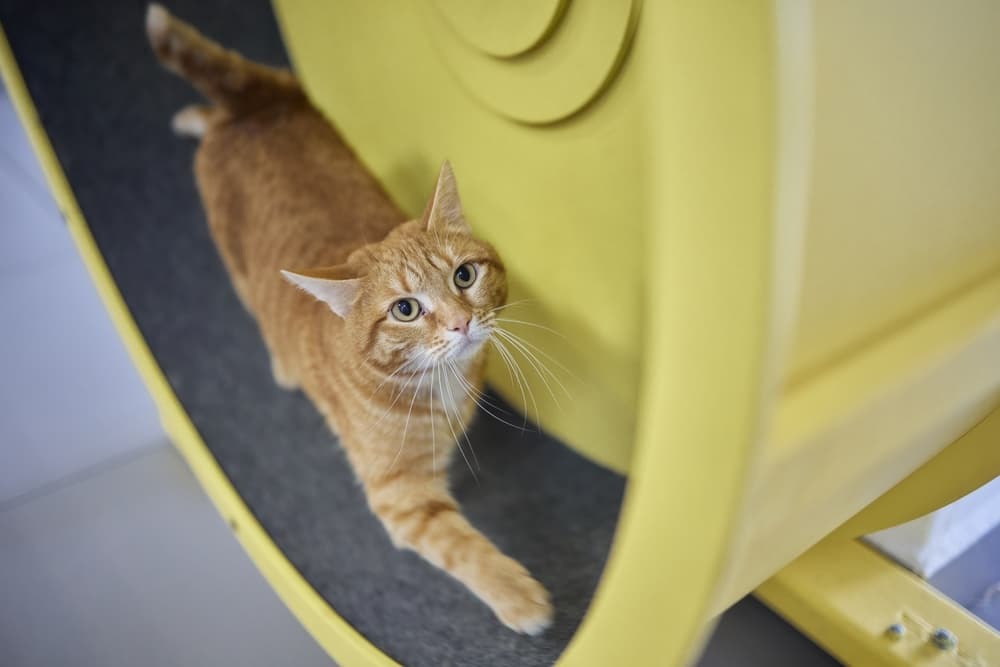Rotten Dog Teeth: Causes, Signs, and What to Do

Rotten dog teeth is a broad, non-technical term that can describe any form of dental disease in dogs. However, it generally evokes thoughts of teeth that are discolored, falling out, and painful. Sadly, rotten teeth are very common in our canine companions. After all, dogs don’t brush their teeth and they rely on their pet parents to manage their dental hygiene.
Interestingly, dogs do not get cavities the way humans do. Cavities, known as dental caries, are caused by two specific types of bacteria (Streptococcus mutans and Streptococcus sobrinus) which dogs do not have. They do however develop very severe dental disease including rotten teeth and gums.
Here, we’ll outline the causes of periodontal disease, how to spot rotten teeth, and what you can do to prevent dog tooth decay.
What Do Rotten Dog Teeth Look Like?
Most pet parents don’t routinely look closely at their dog’s teeth. This is because dogs don’t generally appreciate fingers in their mouths. So the visual appearance isn’t the first sign that pet parents notice in dogs with rotten teeth. One of the first signs of tooth decay in dogs that pet parents notice is bad breath.
Dog teeth, like human teeth, are made of a crown (the part you can see) and the root. The root is under the gingiva (medical term for the gums) and is the part that both anchors the tooth in place and connects it to the body’s blood supply. Deep inside of the tooth, from the root to the crown, is the pulp. This is the living part of the tooth and the part that becomes very painful when teeth are rotten.
Some rotten teeth are covered in a thick layer of gray-brown-green plaque, also known as calculus. This is usually worst on the teeth in the back of the mouth (premolars and molars) where it is most difficult to see. However, it can also develop on the canines and incisors (front teeth).
Sometimes the crown of the tooth looks normal but there is severe infection underneath the gums. This makes the gums look red or bleed easily and is known as gum disease or gingivitis.
Another sign of rotten teeth in dogs include exposure of the roots due to decay of the gingiva, the jaw bone, and the structures that attach the tooth to the bone. This is known as periodontal disease. This can be seen as retraction of the gum line so that the tooth looks longer than it used to or you may even see multiple roots of premolars and molars.
Signs and Symptoms of Rotten Teeth in Dogs

The most common first sign of rotten dog teeth that pet parents notice is bad breath (halitosis). This is due to bacteria building up in the mouth. Over time these bacteria can destroy the gums, teeth, and even the jaw bones.
Just like in humans, dental disease in dogs is painful. In addition to bad breath, pet parents may notice:
- Discoloration of teeth
- Loose teeth
- Broken or missing teeth
- Swollen areas of the face (including under the jaw or under the eye)
- Bleeding from the mouth
- Discharge from the eye or nose
In the early stages of periodontal disease, dogs may bleed from their gums on chew toys or develop very red inflamed gums after playing with those toys.
Some dogs with rotten teeth will be unwilling to eat hard foods or any foods at all. Or they may only chew food on one side of their mouth. Dogs with rotten teeth may stop playing with their favorite chew toys or stop playing fetch. These are signs of mouth pain.
Other signs of mouth pain include:
- Excessive drooling
- Rubbing or pawing at the face
- Bleeding from the mouth
- Not wanting to be touched on the head or muzzle
In the final stages of dental disease, teeth will become very loose and fall out. When rotten teeth fall out they leave a pocket where bacteria can thrive and continue to cause pain.
What Causes Rotten Dog Teeth?
Tooth decay in dogs is caused by several factors. The most important one is lack of dental care and dental hygiene. Brushing a dog’s teeth every day with a veterinarian-recommended dog toothpaste significantly decreases the risk they will develop dental disease.
But, it doesn’t eliminate the risk. Breed genetics and conformation (shape of the face and mouth) also contribute to the risk of rotten teeth in dogs. Some breeds such as Dachshunds and Yorkies are cursed with bad dental genetics. In these breeds even daily brushing may not be enough to prevent dental disease.
Similarly, brachycephalic (short-faced) dogs – like French Bulldogs, Pugs, and Shih Tzus – and those with under- or over- bites (malocclusion) are at a higher risk of developing dental disease. This is because these dogs have crowded mouths and are more likely to develop rotten teeth.
Aging itself is not a risk factor. Rather, years of poor dental hygiene are most noticeable in older dogs.
The Dangers of Rotten Dog Teeth
Rotten and decaying teeth are painful and dangerous for dogs. Not only can they make your pet not want to eat or drink, but they can lead to other diseases.
Dental disease puts dogs at risk for the development of heart disease. It causes elevated liver enzymes which may impact how your dog can tolerate medications. Rotten teeth also weaken the jaw bone around them leading to future dental loss and putting your dog at risk for a jaw fracture.
It is important not to underestimate the severity of pain and discomfort that rotten teeth can cause. Dogs explore their world with their mouths – which includes playing with their toys and grooming themselves. Dogs with painful mouths may stop grooming and even stop playing with their toys.
What to Do If Your Dog Has Rotten Teeth

If you think your dog has a rotten tooth, schedule an appointment with your veterinarian right away since extraction of the tooth may be required.
If your dog is in a lot of pain, you may need to visit an emergency clinic to start pain control and antibiotics before being able to see your regular veterinarian for a dental procedure. Unfortunately, most emergency clinics do not have the equipment to perform dental procedures so they cannot replace an appointment with your regular veterinarian.
By the time your pet is showing signs of rotten teeth it is too late to start brushing. Nothing you can do at home will eliminate the bacteria or do anything to address the rotten teeth.
If your dog is not eating dry food and you think it is because of dental disease, you can feed a canned or wet dog food diet until your dog is seen by your vet. However, changing their diet will not eliminate the pain or the infection.
Dog Tooth Cleaning and Extraction
If your veterinarian recommends extracting a tooth or multiple teeth, listen to their advice. Rotten teeth will not get better with antibiotics. Diseased teeth are painful and if left in the mouth can exacerbate dental disease of the teeth around them.
During an extraction procedure, your veterinarian will anesthetize your pet and use an ultrasonic scaler to remove bacteria under the gums as well as any calculus on the teeth. Dental X-rays (radiographs) will pinpoint any areas of disease deep within the bones. The severity of dental disease is characterized by several factors including mobility of the tooth, root exposure, and evidence of infection of the root on dental X-ray.
Teeth that are diseased should be extracted. Depending on the tooth or teeth involved and the severity of disease some extractions are very simple while others require drilling the tooth out of its socket. Interestingly, sometimes it is the most severely rotten teeth that require the most work to extract.
After the procedure your veterinarian will prescribe pain control and may recommend a soft diet for several days while your dog’s mouth heals.
How to Prevent Tooth Decay in Dogs

The best and most effective thing you can do to prevent tooth decay in dogs is daily brushing. While that may feel impossible, it is made easy through positive reinforcement training with the toothbrush and toothpaste that comes in flavors dogs like (chicken, bacon, etc). Do not use human toothpaste when brushing your dog’s teeth. If you need help training your dog to accept brushing, talk to your veterinarian or local dog trainer.
Some foods, dental chews, and toys can help slow the development of dental tartar and gingivitis. These items have a special symbol on their label with the letters VOHC. This stands for the Veterinary Oral Health Council, a group that promotes dental health through tested products.
It is an old wive’s tale that hard kibble helps prevent dental disease. There are some diets specially formulated to help reduce the risk of dental disease, this list of foods can be found at the VOHC website.
Similarly, hard bones, antlers, and the like can be good chew toys but they can also fracture teeth. The general rule of thumb is that anything harder than your fingernail can damage dog teeth.
And the value of regular check-ups with a veterinarian cannot be ignored. Your veterinarian is able to look at all of your dog’s teeth and is trained to notice early signs of dental disease. It is much easier (less painful for your dog, less expensive for you) to keep your dog’s mouth healthy than to treat dental disease after it happens.









